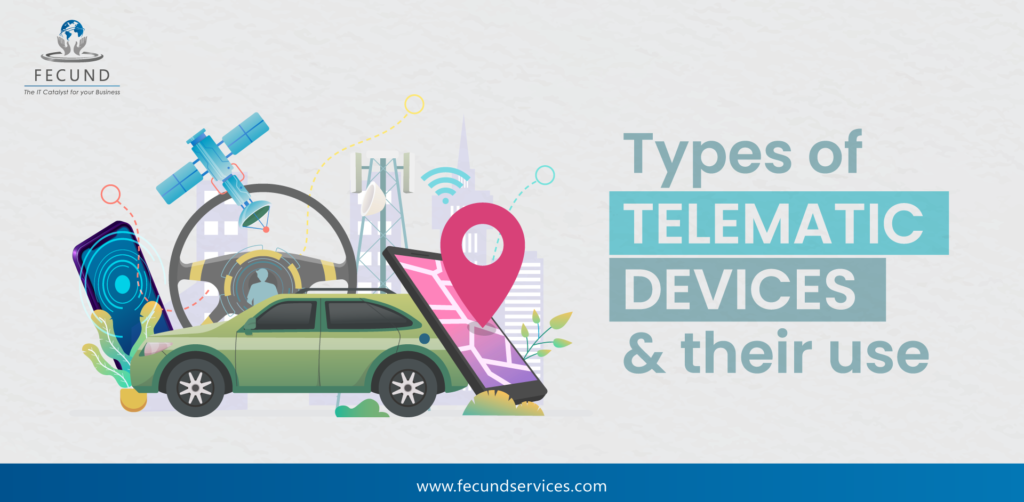
A Telematic is a device installed in the vehicle to collect the data about the vehicle and transfer it to the assigned platform. In FECUND’s last blog, you read about how telematics devices provide good ROI to the insurance business.
This article will talk about the types of telematics devices and how the insurer is using them to support customers. Telematics performs multiple functions, from collecting information about vehicle status, machine condition, vehicle locations to the transit details. It gets all the possible data as assigned to telematics devices. Telematics is essentially designed to support fleet management companies to manage their people and business. Because telematics is equipped with GPS, data collection, and data transfer, it is now also being used in non-commercial vehicles too other advanced technologies like Artificial Intelligence. Machine Learning is now also being used in non-commercial vehicles.
Multiple industries currently use the information collected from telematics. The data from telematics devices is collected, processed, and developed into a useful form. Some common uses of this are sending medical emergencies, evidence collection, preventing theft, fraud detection, controlling drivers’ behaviors, and understanding vehicle requirements.
Many fleet management companies have shared that due to the easy checking process of the vehicle through the telematic dashboard. They can prevent delayed product delivery and prevent accidents because of machine failure. It takes very little time for the fleet managers to check the condition of the carrier.
The big brother feeling of the telematics devices has kept drivers more aware about their driving. They became more controlled drivers, and just in case of any accidents or problems, they can easily send a signal to get a medical emergency. Many cases show that telematics technology has saved the lives of many people. The fleet industry has managed to save the lives of their many drivers as they can quickly get informed about the situation.
Telematics is the combination of two advanced technologies: Telecommunication and informatics.
Just like another industry, telematics technology supports the insurance industry by providing historical and real-time data. Historical data help with the policy applicant verification, accidental history, while real-time data is used for policyholder’s claim approval by understanding the current situation of the insured assets. The information collected from telematics simplifies most processes like underwriting, claim clarification, decision making, and many more. Telematics consists of AI and ML systems that easily identify the problem while driving the vehicle. Prevented accidents and instant accidental help have saved businesses from incurring huge losses and insurance companies to get more claims. Many fleet companies are hoping to get affordable accident prevention technology in the vehicle, saving lives and business.
Here is a list of the telematics devices currently used by the fleet industry.
Smartphone / Mobile
Smartphones are the most convenient and cost-effective way of telematics solutions. A mobile app uses built-in smartphone sensors to detect driving activity. The effective GPS receiver is equipped in smartphones that help to access and track the vehicle. Complete travel data is collected and transferred from the smartphone for analysis.
Bluetooth-Enabled Self-Powered Devices
The Bluetooth-enabled devices are united with smartphone apps. The devices are directly fixed in the vehicle. Many pre-1996 vehicles are implemented with this technology. The device collects all the data and transfers it into understandable information. This information is used to improve the driving experience. This device is also known as household telematics. It is commonly used by low-risk drivers, new learners, young drivers who use the vehicle for non-commercial or personal use.
Bluetooth-Enabled On Board Diagnosis
This Bluetooth-enabled fixed plug-in device collects driving data which is then transmitted via a smartphone for analysis. It is used mainly by high-risk drivers. As in many insurance policies, mileage is one of the primary factors to identify the premium amount. This is the vehicle-centric evaluation that focuses on the mileage.
OBD (On Board Diagnosis)
Many mature drivers look for the option which helps them to save on premiums. OBD is a cellular network-based device. This device collects the driving data and transmits it to the cellular network. It is used by senior-level drivers who are highly experienced in vehicle driving.
Hard-wired Telematics Device
The main component of the Hard-wired devices is the Telematics Control Unit (TCU). TCU consists of a GPS unit, a cellular/ mobile communication unit, and a microprocessor unit. Hardwire devices collect the data with the help of these units and transmit data through a wireless system.
Hard-wired devices are solid and secure telematics devices as they can be directly implemented in the vehicle. By using the battery of the vehicle, they get attached to the electrical connections of the vehicle.
Black Box
A black box is a small box fitted inside the vehicle. It measures the various aspects of the vehicle and transfers them to the insurance companies. The black box is a device that is more reliable and flexible. It encourages low mileage insurance. It is easy to install in the vehicle as it is technically sophisticated.
Conclusion:
Telematic is created to encourage safe driving behavior. Insurance companies reward such behavior by providing Pay-as-you-drive insurance policies that involve telematic devices. As per the need of the customer, they can select the telematics device for their vehicle. It is up to the type of vehicle, use of the vehicle, and driver’s experience that decide the best telematics device for the company.




Post a comment